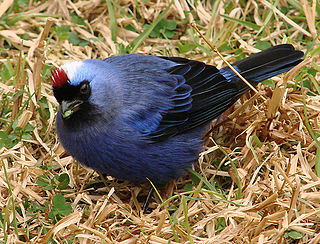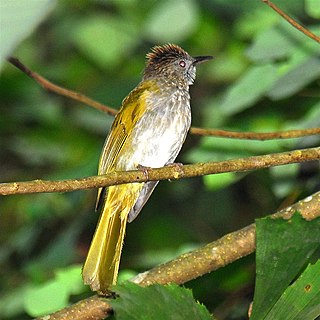
The whistling thrushes comprise a genus Myophonus of the Old World flycatcher family Muscicapidae.

The forktails are small insectivorous birds in the genus Enicurus. They were formerly placed in the thrush family, Turdidae, but are now treated as part of the Old World flycatcher family, Muscicapidae. Their common name derives from their long forked tail.

Coenraad Jacob Temminck was a Dutch patrician, zoologist and museum director.

The besra, also called the besra sparrowhawk, is a bird of prey in the family Accipitridae. It was formerly placed in the genus Accipiter. The name "besra" is from the Hindi word for the species.

The crested goshawk is a bird of prey in the family Accipitridae that is widely distributed in tropical Asia. It was formerly placed in the genus Accipiter.

The diademed tanager is a species of Neotropical bird in the tanager family Thraupidae. It is the only member of the genus Stephanophorus. It is purple-blue with a white crown characterised by a small red patch, and it is found mostly in open areas in southern Brazil, northeast Argentina, and Uruguay.

Emberizoides is a small genus of finch-like tanagers found in grassy areas in Central and South America.

The western bearded greenbul is a species of songbird in the bulbul family, Pycnonotidae. It is found in West Africa. Its natural habitats are subtropical or tropical dry forests and subtropical or tropical moist lowland forests.

Ixos is a genus of passerine birds in the bulbul family, Pycnonotidae.

The Javan blue-banded kingfisher, is a species of kingfisher in the subfamily Alcedininae. It is endemic to and found throughout Java, but is thought to be extremely rare due to human pressures such as habitat destruction. Its natural habitats are subtropical or tropical moist lowland forest, subtropical or tropical mangrove forest, and rivers. Its population is estimated to be just 50-249 individuals, and is believed to be in decline.

The black-masked finch is a species of South American bird in the tanager family Thraupidae. It is the only member of the genus Coryphaspiza. It is found in Argentina, Bolivia, Brazil, Paraguay, and Peru. Its natural habitats are subtropical or tropical moist shrubland, subtropical or tropical dry lowland grassland, and subtropical or tropical seasonally wet or flooded lowland grassland. It is threatened by habitat loss.

The Sunda forktail is a species of bird in the family Muscicapidae. It is endemic to Indonesia, where it is restricted to the islands of Java and Sumatra. Its natural habitat is boulder strewn streams in tropical moist montane forest from 600–2000 m. More rarely the species occurs closer to sea level. The species is common in Sumatra, but is rarer in Java, where the white-crowned forktail is more common.

The elegant pitta is a species of passerine bird in the pitta family Pittidae. It is endemic to Indonesia, where it is found in the Lesser Sunda Islands and Moluccas.

The crescent-chested babbler is a babbler species in the family Timaliidae and is native to the Indonesian islands of Java and Bali. It inhabits subtropical or tropical moist lowland forest, montane forest and shrubland. It is listed as Least Concern on the IUCN Red List.

The orange-backed woodpecker is a bird in the woodpecker family Picidae, found in southern Thailand, Malaya, Sarawak and Sabah in Malaysia, Brunei, Sumatra, and Java. It is monotypic in the genus Reinwardtipicus. It is a forest specialist that is found primarily in the canopy.

Picumnus is a large genus of piculets. With a total length of 8–10 cm (3–4 in), they are among the smallest birds in the woodpecker family. All species are found in the Neotropics except the speckled piculet that has a wide distribution in China, India and Southeast Asia.

Van Hasselt's sunbird, is a species of bird in the family Nectariniidae. It is found in Northeast India, Bangladesh and Southeast Asia. Its natural habitats are subtropical or tropical moist lowland forests and subtropical or tropical mangrove forests.

This article provides a summary of significant events in 1820 in birding and ornithology. Notable occurrences in 1820 include the first description of the yellow-legged tinamou, and the commencement of ornithologist William Swainson's Zoological Illustrations, a work including illustrations of many birds.

The ornate sunbird is a species of bird in the sunbird family Nectariniidae that is endemic to Mainland Southeast Asia, Sumatra, Java, Borneo and the Lesser Sunda Islands. It was formerly considered to be a subspecies of the olive-backed sunbird, now renamed the garden sunbird.

The Sumba flowerpecker is a species of passerine bird in the flowerpecker family Dicaeidae that is found on the Indonesian island of Sumba, one of the Lesser Sunda Islands. Its natural habitat is subtropical or tropical moist forest. It was formerly considered to be a subspecies of the blood-breasted flowerpecker, now renamed the Javan flowerpecker.




















